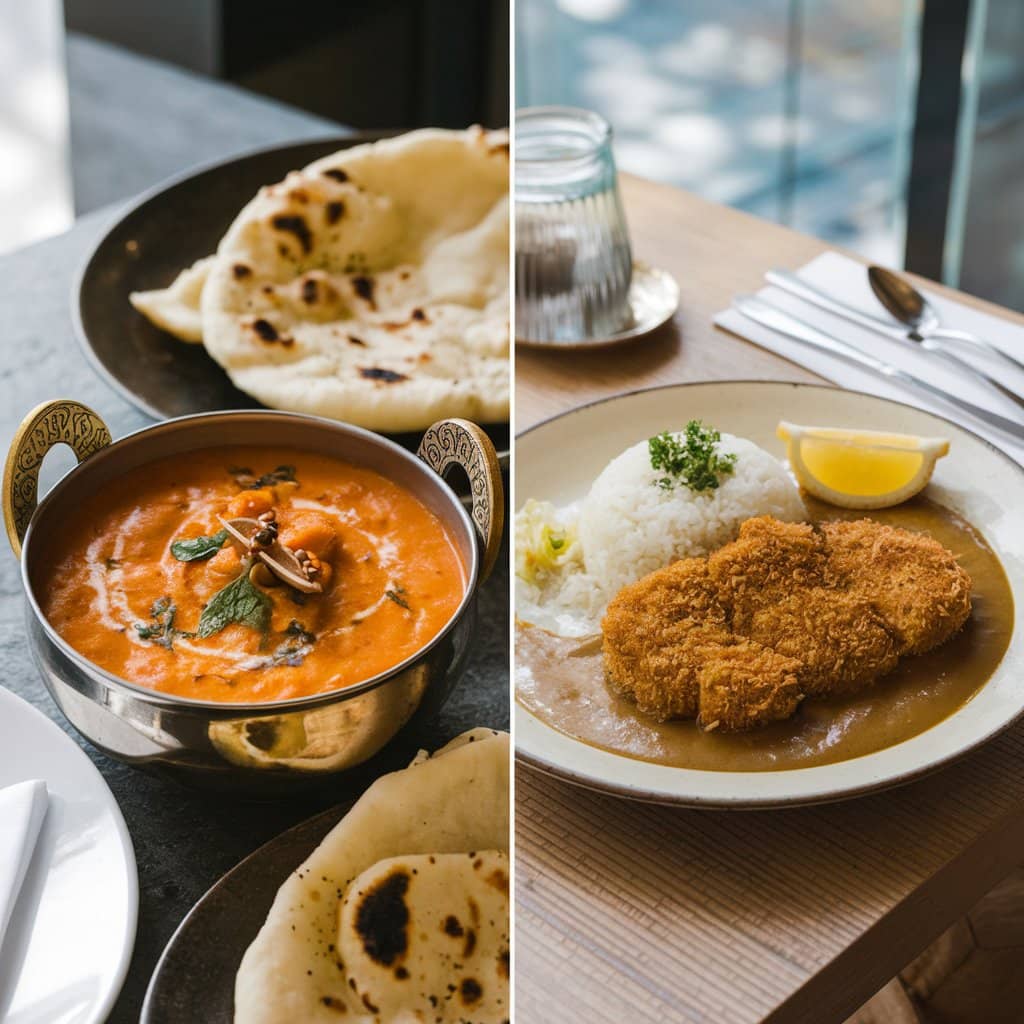What Is the Difference Between Curry and Katsu Curry? Curry is one of the most popular dishes worldwide, celebrated for its complex blend of spices and satisfying richness. However, when exploring Asian cuisine, particularly Japanese food, many encounter “katsu curry” and wonder how it differs from regular curry. While both dishes share similar roots, they differ significantly in preparation, ingredients, and presentation. This article breaks down the key distinctions between curry and katsu curry, helping you understand what makes each unique and delicious.
Table of contents
Curry Overview
History of Curry
Curry originated in South Asia, primarily in India, where it has been a culinary staple for thousands of years. As a result, its rich and flavorful recipes gained popularity across the region. Later on, British colonizers brought curry recipes back to Europe, thus spreading the dish globally. Over time, curry evolved into various styles, from Indian and Thai curries to British curries, each with distinct flavors and cooking techniques. In addition, cultural exchanges influenced curry recipes, making them adaptable and beloved worldwide. Consequently, curry has become a symbol of global culinary diversity.
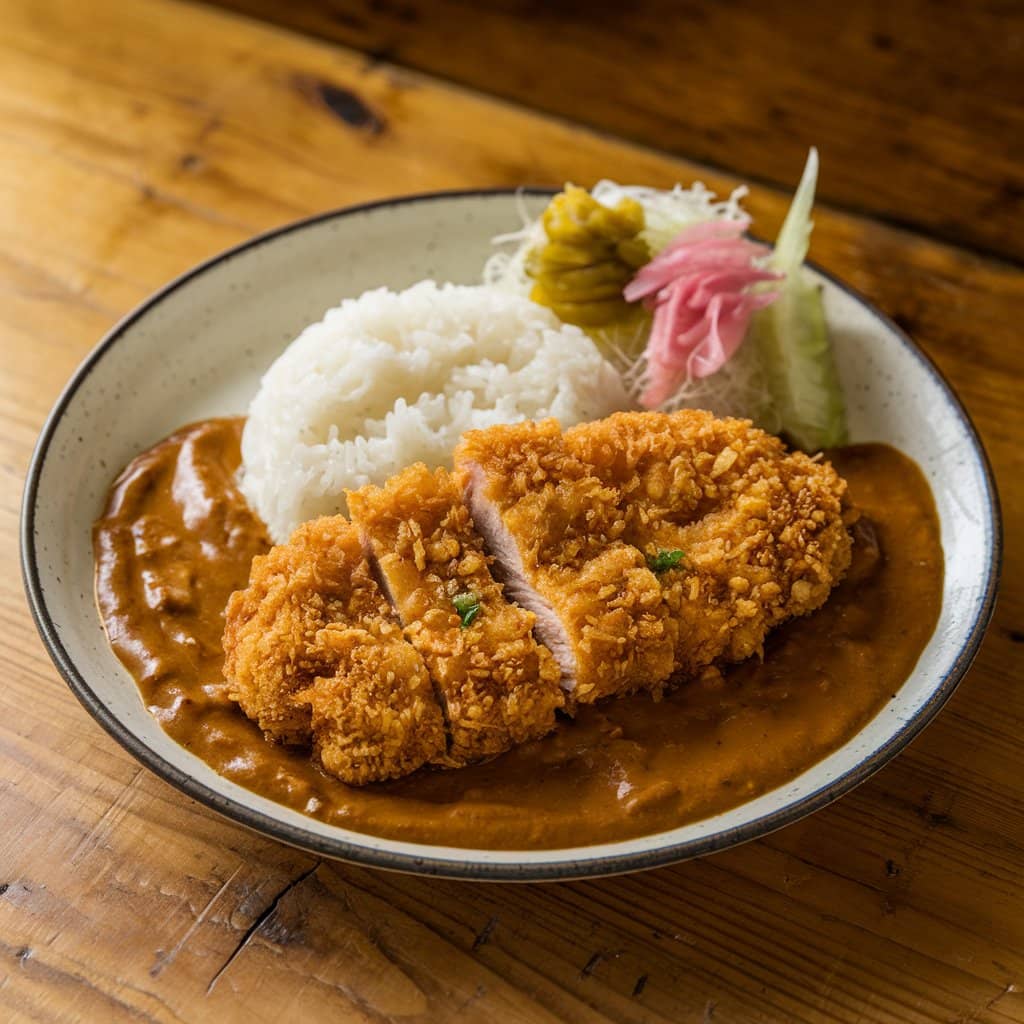
Types of Curry Around the World
Curry varies depending on the region and ingredients used. Some popular varieties include:
- Indian Curries: Such as tikka masala, butter chicken, and vindaloo, featuring rich, spiced gravies often thickened with yogurt or cream.
- Thai Curries: Known for using coconut milk, fresh herbs like lemongrass, and bold spices like red or green chilies.
- British Curries: Adapted from Indian recipes, often featuring mild, creamy sauces such as korma or madras.
Common Curry Ingredients
Curry recipes are highly flexible but typically include:
- Proteins: Chicken, beef, lamb, seafood, or plant-based alternatives like tofu and lentils.
- Vegetables: Potatoes, carrots, peas, and bell peppers.
- Spices and Aromatics: Cumin, coriander, turmeric, garlic, ginger, and garam masala.
- Sauce Base: Tomato puree, coconut milk, or cream, depending on the style.
Katsu Curry Overview
Origin of Katsu Curry
Katsu curry is a unique Japanese dish that combines two culinary influences: Japanese-style curry and “katsu,” a breaded and fried cutlet. The British introduced curry to Japan in the late 19th century, while European cuisine, specifically dishes like schnitzel, inspired the concept of the breaded cutlet. The combination of the two resulted in katsu curry, now a beloved comfort food in Japan.
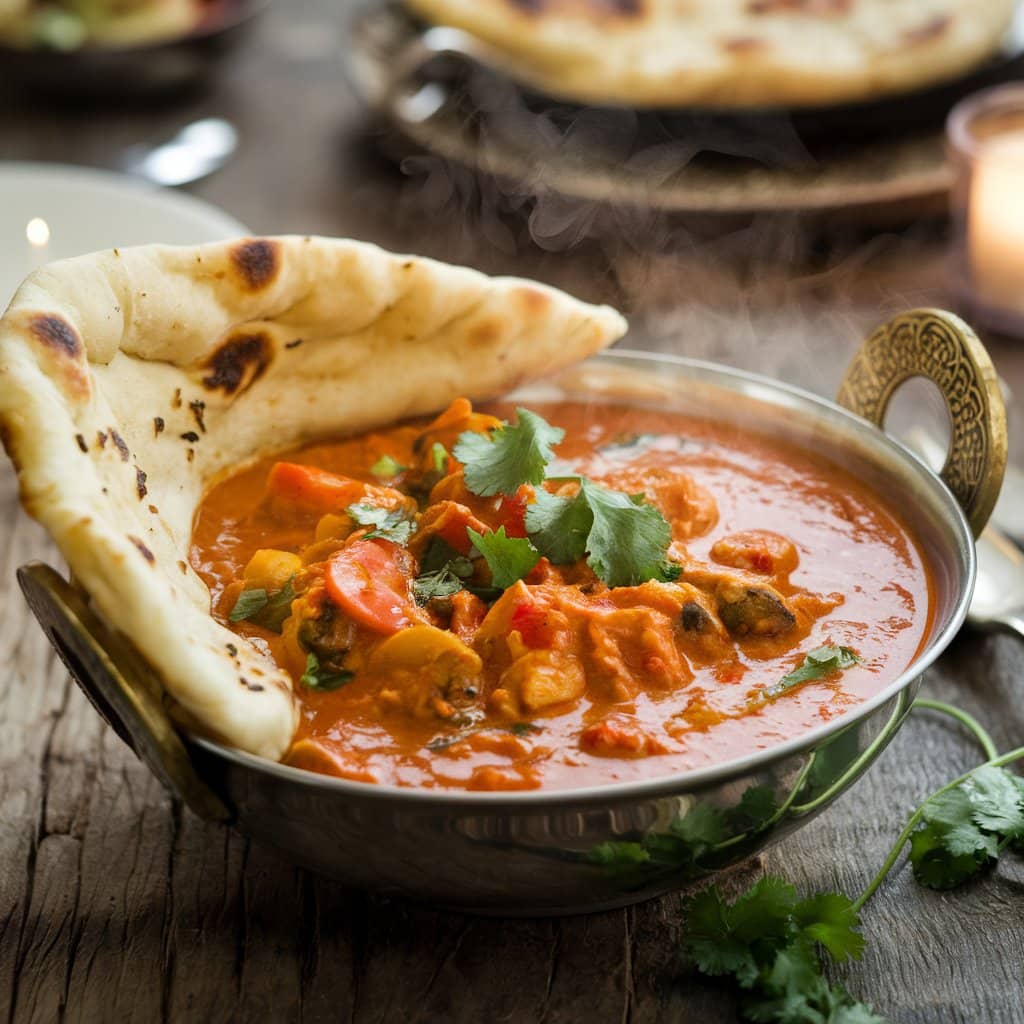
Key Features
Katsu curry stands out due to its distinctive composition, which includes:
- Crispy Cutlet (“Katsu”): A breaded and deep-fried pork or chicken cutlet.
- Japanese Curry Sauce: A mild, thick curry sauce made from curry roux, often featuring a slightly sweet and savory flavor.
- Steamed Rice: Served alongside the cutlet, balancing the rich flavors of the curry.
- Pickled Garnishes: Such as fukujinzuke (sweet pickled vegetables) or rakkyo (pickled shallots).
How Katsu Curry Is Served
Chefs typically plate the dish with rice on one side, place the breaded cutlet on top, and pour the curry sauce generously over both. In contrast, cooks serve many Indian and Thai curries differently by simmering all ingredients together in a single pot. As a result, katsu curry’s presentation highlights the crispy texture of the cutlet, while traditional curries emphasize a harmonious blend of flavors. Additionally, the separated components in katsu curry create a visually appealing and well-structured presentation.
Preparation Differences
Heading 3: Cooking Method for Curry
The preparation of traditional curry involves simmering ingredients together to create a rich, flavorful sauce. Here’s how typical curry is made:
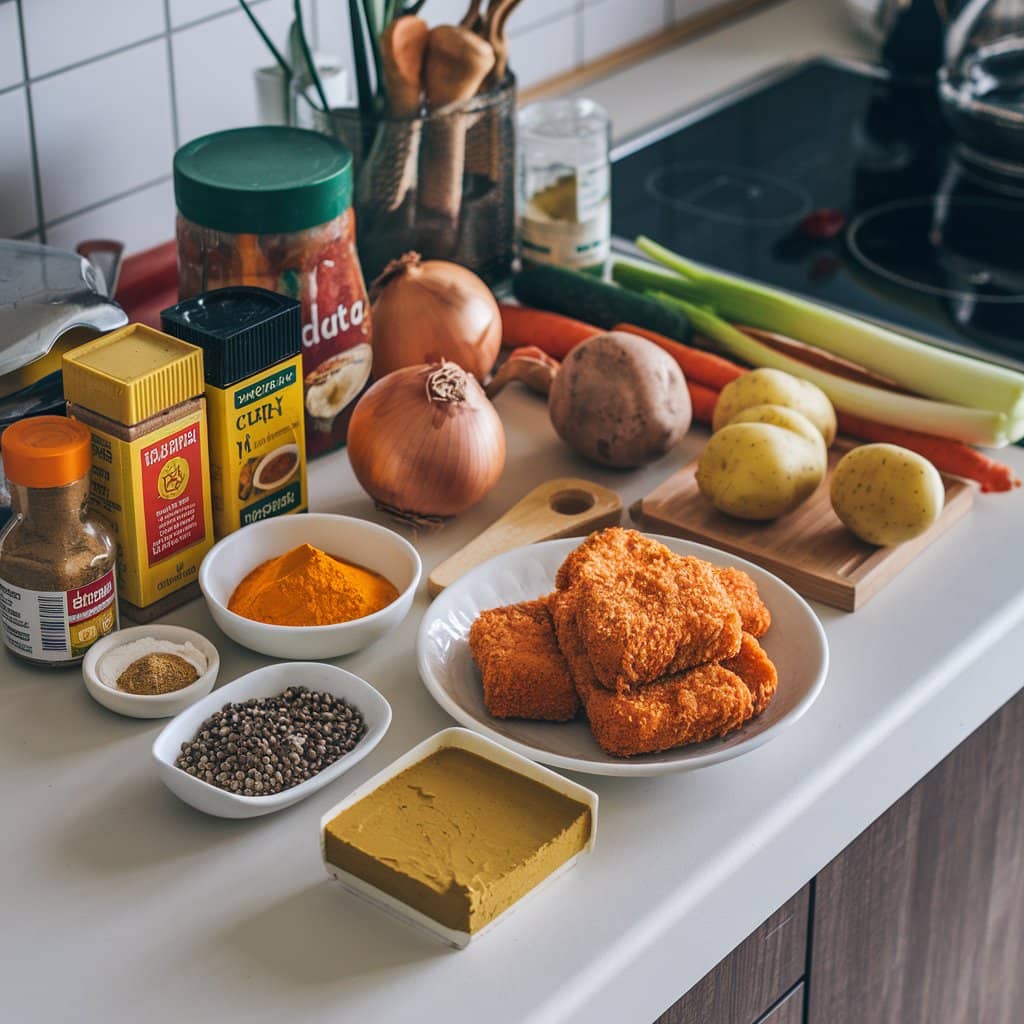
- Sautéing Aromatics: Onions, garlic, and ginger are cooked until golden brown to build the base of the curry.
- Adding Spices: Spices like turmeric, cumin, coriander, and garam masala are toasted to release their aroma.
- Building the Sauce: Tomatoes, coconut milk, or cream are added to create a smooth sauce.
- Simmering: Meat or vegetables are simmered in the sauce, allowing flavors to blend.
The process can be lengthy, with the sauce often cooked slowly for maximum depth of flavor.
Cooking Method
Katsu curry follows a completely different preparation method, combining two separate cooking processes. First, the curry sauce is prepared by sautéing onions, carrots, and potatoes until softened. Then, a curry roux made from flour, butter, and curry spices is added, creating a thick, flavorful sauce. Meanwhile, the meat is breaded by coating it in flour, dipping it in beaten egg, and covering it with crispy panko breadcrumbs. Finally, the breaded meat is deep-fried until golden brown and served with steamed rice and curry sauce poured on top. Thus, the dish offers a perfect balance of crispy, savory, and mildly spiced flavors.
- Making the Curry Sauce:
- Sautéing Vegetables: Onions, carrots, and potatoes are cooked in a pan.
- Adding Curry Roux: A store-bought or homemade curry roux block (made from flour, butter, and curry spices) is melted into the mixture.
- Simmering: The sauce is simmered until thick and flavorful.
- Preparing the Katsu Cutlet:
- Breading the Meat: Chicken or pork is coated in flour, dipped in beaten egg, and covered with panko breadcrumbs.
- Frying: The breaded meat is deep-fried until golden brown and crispy.
Once both components are ready, the crispy katsu is placed on a plate with rice, and the curry sauce is poured on top or served on the side.
Heading 2: Main Ingredients Comparison
Curry Ingredients Overview
Traditional curry recipes vary widely depending on the region, but they typically balance proteins, vegetables, spices, and a flavorful sauce base. Below is a breakdown of key components:
- Proteins: Common choices include chicken, beef, lamb, fish, tofu, or lentils.
- Vegetables: Potatoes, carrots, bell peppers, tomatoes, spinach, and eggplants are often used.
- Spices and Herbs: Cumin, coriander, turmeric, cinnamon, cardamom, and curry powder are essential. Fresh herbs like cilantro may be added as a garnish.
- Sauce Base: The sauce can be tomato-based, yogurt-based, or made with coconut milk, depending on the cuisine.
- Aromatics: Onions, garlic, and ginger form the flavor foundation of most curries.
Ingredients Breakdown
Katsu curry uses simpler ingredients, reflecting its Japanese adaptation of British-style curry. Specifically, its key components include:
- Meat for the Cutlet (“Katsu”): Typically pork (tonkatsu) or chicken breast, coated in panko breadcrumbs for extra crunch.
- Japanese Curry Roux: A pre-made curry roux block made from flour, oil, and spices, creating a thick and mildly spiced sauce.
- Vegetables for the Sauce: Onions, carrots, and potatoes add sweetness and texture to the dish.
- Rice: Short-grain Japanese rice, known for its sticky texture, pairs perfectly with the curry sauce.
- Pickles and Garnishes: Sweet pickled vegetables like fukujinzuke or rakkyo provide a tangy contrast.
Overall, the dish balances simplicity and comfort, making it easy to prepare while delivering a satisfying and flavorful experience.
Key Ingredient Difference Summary:
- Curry: Features a diverse range of proteins, vegetables, and homemade spice blends.
- Katsu Curry: Focuses on a fried, breaded cutlet paired with a thick, mild curry sauce made from a packaged roux.
Taste and Texture Differences
Curry Flavor Profile
The taste of curry varies based on regional styles, but its defining feature is a complex mix of spices creating a bold, aromatic, and sometimes spicy experience. Key flavor characteristics include:
- Spicy and Earthy Notes: Ingredients like cumin, coriander, and chili peppers provide warmth and heat.
- Rich and Creamy Base: Coconut milk, yogurt, or cream can mellow the spices and create a silky texture.
- Sweet and Tangy Elements: Tomatoes, tamarind, and even fruits like mango are used for balance.
- Layered Flavors: Slow cooking helps develop deep, well-rounded flavors with a lingering aftertaste.
Texture: Depending on the style, curries vary in texture from thick and creamy, like tikka masala, to broth-like, such as Thai green curry. Cooks frequently adjust the sauce consistency by adding water, coconut milk, or cream.
Flavor Profile
Katsu curry delivers a much simpler and milder taste, emphasizing comfort and richness rather than intense spice blends. Its defining features include:
- Mild and Savory: The curry sauce is mildly spiced and slightly sweet, appealing to a broader range of palates.
- Umami-Rich: The fried cutlet adds a savory, satisfying depth due to its crispy, golden crust.
- Sweet and Balanced: The combination of sautéed onions, carrots, and potatoes contributes natural sweetness to the sauce.
Texture: The crispy breaded cutlet contrasts beautifully with the smooth, thick curry sauce. Even after cooks pour the sauce over the cutlet, the panko coating stays crunchy, providing a satisfying texture with every bite. Furthermore, this crispy layer complements the softness of the simmered vegetables and the fluffy steamed rice. As a result, katsu curry offers a perfect blend of textures, where the crispiness of the cutlet enhances the creamy, velvety curry sauce for a well-balanced and enjoyable eating experience.
Key Taste and Texture Differences Summary:
- Curry: Intense, bold, and spiced with complex layers of flavor. Texture varies from thick and creamy to soupy.
- Katsu Curry: Mild, slightly sweet, and savory with a focus on the crispy cutlet and thick, smooth sauce.
Cultural Significance
Curry’s Global Popularity
Curry has a deep cultural significance across many countries, with each adapting it to their local tastes and traditions. For example, in India, curry reflects regional diversity, featuring countless spice combinations and cooking techniques. Similarly, in the United Kingdom, curry has become a national favorite, blending Indian flavors with British culinary preferences. Moreover, Thai curries emphasize bold, aromatic ingredients like coconut milk and lemongrass, creating a unique flavor profile. As a result, curry has evolved into a globally cherished dish, symbolizing cultural exchange and culinary creativity.
- India: The birthplace of curry, where it is a staple of daily meals. Indian curry reflects regional diversity, from the spicy vindaloo of Goa to the creamy butter chicken of North India.
- United Kingdom: Curry became Britain’s favorite dish, with iconic creations like chicken tikka masala often regarded as a national dish.
- Thailand: Thai curry emphasizes balance between sweet, sour, salty, and spicy flavors, becoming a global favorite.
- Africa and the Caribbean: Curries here incorporate unique local spices like allspice, creating distinctive dishes such as Jamaican curry goat.
Curry’s widespread appeal stems from its adaptability, allowing people worldwide to modify it with locally available ingredients. For instance, Caribbean curries often include tropical spices like allspice and scotch bonnet peppers, while Japanese curry features a milder, sweeter flavor profile. Additionally, Southeast Asian countries like Thailand incorporate coconut milk, lemongrass, and galangal for a distinct taste. Because of this flexibility, curry has seamlessly integrated into various cuisines, making it a beloved dish enjoyed across diverse cultures and culinary traditions.
Katsu Curry in Japanese Culture
Katsu curry holds a special place in Japanese cuisine as one of the most beloved comfort foods. Its cultural roots trace back to the late 1800s, when Japan modernized its cuisine by incorporating Western elements like breaded meat.
- Everyday Meal: Katsu curry is a go-to meal in Japanese homes, school cafeterias, and casual restaurants.
- Symbol of Comfort: It’s synonymous with warmth, nostalgia, and homestyle cooking, similar to how mac and cheese or meatloaf are viewed in Western cultures.
- Iconic Restaurant Dish: Many Japanese restaurants, from fast-food chains like CoCo Ichibanya to traditional eateries, feature katsu curry prominently on their menus.
- Cultural References: Katsu curry frequently appears in Japanese pop culture, anime, and films, reinforcing its role as a national comfort dish.
Key Cultural Significance Comparison:
- Curry: A global dish with deep historical roots, symbolizing cultural exchange and culinary innovation.
- Katsu Curry: A uniquely Japanese adaptation symbolizing the blending of East and West, now considered a comfort-food classic.
Serving Style and Presentation
Traditional Curry Serving Methods
Curry presentation varies significantly depending on cultural traditions and regional customs:
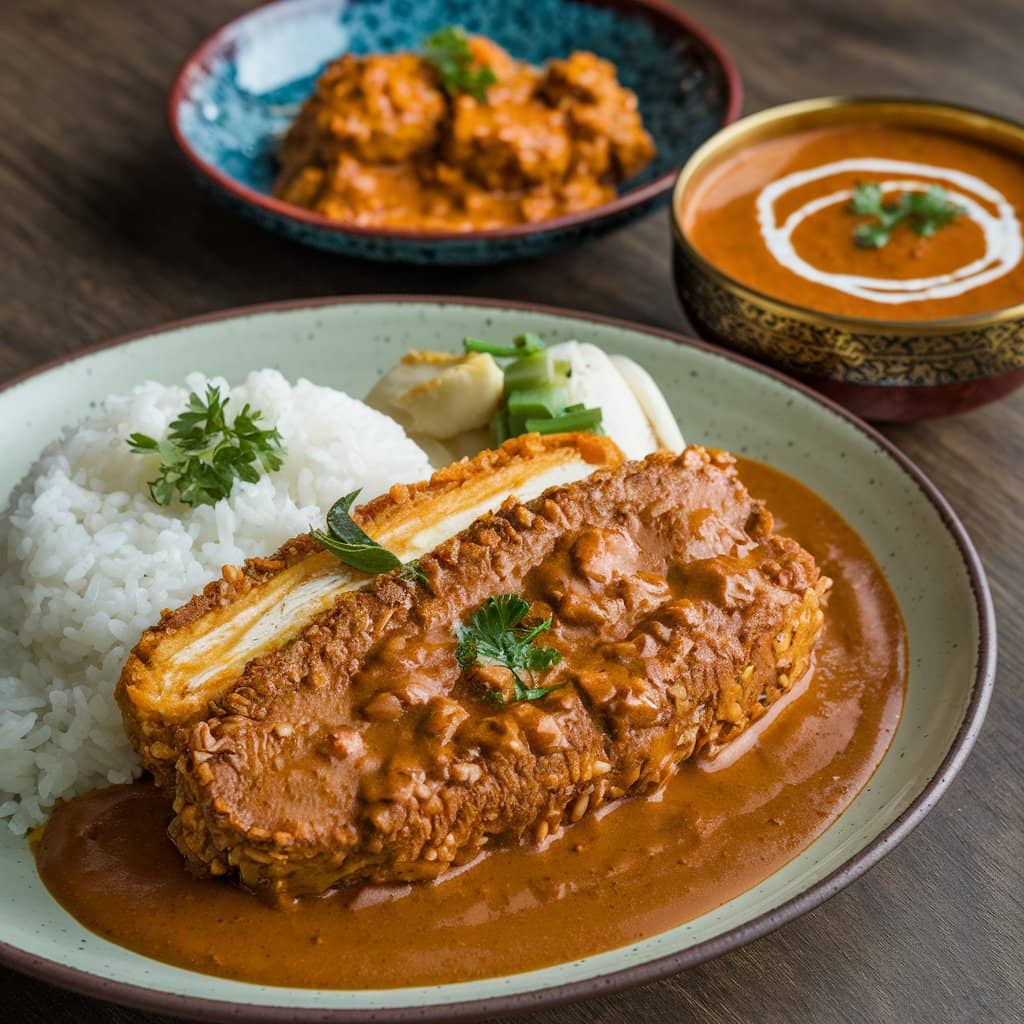
- Indian Curry: Often served in bowls with a variety of accompaniments such as basmati rice, naan, roti, or chapati. Curries may be presented family-style with multiple side dishes like chutneys, pickles, and yogurt-based sauces.
- Thai Curry: Typically served in a deep bowl with jasmine rice on the side or combined into one dish. Garnishes like Thai basil, lime wedges, and chili slices enhance flavor and appearance.
- British Curry: Commonly served with pilau rice, naan bread, and sometimes fries, reflecting its adaptation into British pub culture.
The focus is on serving curry as a communal dish meant for sharing, with an emphasis on bold presentation through colorful garnishes and rich sauces.
Serving Style
Katsu curry follows a more structured presentation style that highlights its main components separately yet harmoniously:
- Plating Layout: The plate is typically divided into three sections: rice on one side, the breaded cutlet on the other, and the curry sauce poured generously over the cutlet and part of the rice.
- Minimalist Presentation: Japanese culinary traditions emphasize simplicity and balance, so the dish often comes with minimal garnishing—perhaps just a sprinkle of parsley or a side of pickled vegetables like fukujinzuke.
- Fast and Functional: Many Japanese curry houses serve katsu curry on stainless steel trays for a classic diner-style experience, emphasizing practicality and ease of eating.
Key Serving Style Differences Summary:
- Curry: Traditionally served family-style with an array of sides and toppings, encouraging communal dining.
- Katsu Curry: Presented as a complete, individual meal with clear separation between rice, curry sauce, and the crispy cutlet.
FAQs
What Is the Main Difference Between Curry and Katsu Curry?
The main difference lies in preparation and presentation. Traditional curry is a spiced, simmered dish with various proteins and vegetables, while katsu curry features a breaded and fried meat cutlet served with a mild, thick curry sauce over rice.
Is Katsu Curry Spicy?
No, katsu curry is typically mild and slightly sweet, making it appealing to people who prefer less spicy food. However, some restaurants offer spicier versions.
Can You Use Different Meats?
Yes, while pork (tonkatsu) and chicken are traditional, beef, shrimp, and even plant-based options like tofu or seitan can be used.
Is Katsu Curry Healthy?
Katsu curry can be calorie-dense due to its fried cutlet and rich sauce. To make it healthier, consider baking the cutlet or using lean meats and more vegetables.
What Kind of Rice Is Best for Curry and Katsu Curry?
For traditional curry, long-grain varieties like basmati or jasmine rice are ideal. For katsu curry, short-grain Japanese rice is best due to its sticky texture, which pairs well with the sauce.
Can I Make Katsu Curry at Home?
Absolutely! In fact, many recipes are beginner-friendly. For example, you can use store-bought curry roux for convenience or, if you prefer a homemade version, make it from scratch using flour, butter, and curry powder. Additionally, when preparing the katsu, simply bread and fry the meat of your choice, and finally, serve it with steamed rice for a delicious and satisfying meal.
Conclusion
Curry and katsu curry may share a common name, but they are distinct in origin, preparation, and presentation. Traditional curry is a versatile, globally influenced dish with deep, spiced flavors, while katsu curry is a Japanese comfort food combining a crispy fried cutlet with a mild curry sauce. Both dishes offer unique culinary experiences, making them beloved by food enthusiasts worldwide. Whether you crave the intense spice of Indian curry or the comforting simplicity of katsu curry, both are worth savoring.

